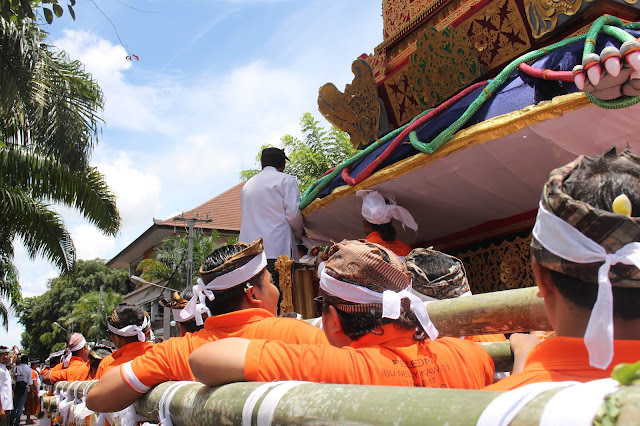Indonesia is a large country, blessed with different traditions in every province and island. In this post, I will gladly talk about my experience in attending a traditional death ceremony in Ubud, Bali.
On February 13th, 2017, I had the chance to attend the Pelebon ceremony for Ibu Nelly Sukawati, the wife of Tjokorda Ngurah Wim Sukawati, the eldest son of President of the State of East Indonesia and former 'King' of Ubud, Tjokorda Gede Raka Soekawati. Because She's a royal family member, the ceremony was festive and witnessed by so many locals and tourists. It was also the first time a Non-Balinese was given a royal cremation in Ubud (Ibu Nelly is Dutch).
There are three parts of the event, they are:
1. Saniscara Umanis Ukir
2. Redite Pon Kualantir
3. Soma Wage Kualantir
All three parts of the event were celebrated three days in a row, each day consisting of different rituals. The invitees can only attend the first and second days, but the rituals on the third day can be watched by anyone. Now I'm only going to talk about 'Puncak Pelebon,' which was held on the 3rd day and is the core part of the whole ceremony when the body was cremated.
Pelebon is basically the same as Ngaben, what's different is whose death it is. Pelebon is what they call it if the one who dies comes from a royal family, while Ngaben is for any Hindunese.
Why is Pelebon such a special event? Because it's only for the royal family since not everyone can pay such a tremendous amount of money to hold this ceremony which can take billions of rupiahs. In the case of Ngaben, sometimes the family of the dead throw the ceremony along with other families at the same time so the expense can be reduced and paid together (and of course, the ceremony is not as festive as Pelebon).
The core of the ceremony was when the body was paraded in a 9-stories tower (They call it badè) that's approximately 25m tall by hundreds of men, moved to the inside part of a black ox statue, and then being cremated inside it. The parade started from Puri Kantor Ubud, around the town, and then stopped by Sentra Dalam Puri. The whole process of the parade was followed by invitees, locals, tourists, and media.
"In Hindu Bali belief, a cremation ceremony symbolizes the cleansing of the soul of the one who has passed away, by returning the physical remains to the original elements from which living creatures are created and thereby releasing the soul from its worldly bonds. A pelebon or ngaben is not a mournful occasion, but rather a way to soothe the soul of the departed and ensure that it is not disturbed by the sobbing of those left behind.
In Balinese tradition, the body is merely a vessel for the soul. When a person dies, it is believed that his soul, or atman, remains near the body. A person's body consists of five elements: fire, air, water, earth, and empty space. These five elements must be returned to nature, to be released so they can find the way to heaven and unite with the Creator. The cremation ceremony is a lengthy process, with many steps both before and after the cremation itself."






0 comments:
Post a Comment